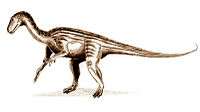Avon Fissure Fill
The Avon Fissure Fill, also known as the Bristol Fissure Fill, is a fissure fill in Avon, England (now Bristol) which dates variously from the Norian and Rhaetian stages of the Late Triassic, or possibly as late as the Hettangian stage of the Early Jurassic.[1] The fissure fill at Avon was a sinkhole formed by the dissolution of Lower Carboniferous limestones.
| Avon Fissure Fill Stratigraphic range: Norian-Hettangian, 216.5–199.6 Ma | |
|---|---|
| Type | Formation |
| Underlies | Lower Carboniferous limestones |
| Location | |
| Region | Europe |
| Country | |
| Extent | Avon (now Bristol) |
| Type section | |
| Named for | Avon county |
It is paired with the nearby Magnesian Conglomerate; it may have been the same formation as the Magnesian Conglomerate.
Paleofauna
| Taxon | Species | Presence | Notes | Images |
|---|---|---|---|---|
| Agnosphitys[1][2] | A. cromhallensis[1][2] | Geographically present in Avon, England (now Bristol).[1] | Its remains include a left ilium (holotype) and a left maxilla, astragalus and humerus (referred specimen).[1] Possibly found in this formation. |  |
| Agrosaurus[3][1] | A. macgillivrayi[3][1] | Geographically present in Avon, England (now Bristol). Originally believed to have been found in Cape York Peninsula, Queensland (Australia).[1] | A tibia, a claw and some other fragments.[1] Possibly found in this formation. | |
| Palaeosaurus[1][4] | P. cylindrodon[1][4] | Geographically present in Avon, England (now Bristol) and Bristol.[1] | Two teeth (one destroyed in 1940).[1] Possibly found in this formation, although it was probably found in the Magnesian Conglomerate instead. |  |
| Rileyasuchus[1][5][6] | R. bristolensis[1][5][6] | Geographically present in Bristol.[1] | Two vertebrae and a humerus.[1] Possibly found in this formation. | |
| Theropoda[1] | Indeterminate[1] | Geographically present in Avon, England (now Bristol) and Bristol.[1] | Indeterminate remains.[1] Possibly found in this formation, although it was probably found in the Magnesian Conglomerate instead. | |
| Thecodontosaurus[1] | Indeterminate[1] | Geographically present in Avon, England (now Bristol) and Bristol.[1] | Indeterminate remains.[1] |  |
gollark: But I meant actual Haskell. Just communicate with the server over UDP.
gollark: Or frege.
gollark: That fixes all bugs.
gollark: We should rewrite it in Haskell.
gollark: It's meant to be the fundamental underpinning of government, not arbitrary traffic light stuff.
References
- Langer, 2004. Basal Saurischia. In Weishampel, Dodson and Osmolska. The Dinosauria Second Edition. University of California Press. 861 pp.
- Nicholas C. Fraser, Kevin Padian, Gordon M. Walkden and A. L. M. Davis, 2002. Basal dinosauriform remains from Britain and the diagnosis of the Dinosauria. Palaeontology. 45(1), 79-95.
- H. G. Seeley. 1891. On Agrosaurus macgillivrayi (Seeley), a saurischian reptile from the N.E. coast of Australia. Quarterly Journal of the Geological Society of London 47:164-165
- Galton, Peter (2007). "Notes on the remains of archosaurian reptiles, mostly basal sauropodomorph dinosaurs, from the 1834 fissure fill (Rhaetian, Upper Triassic) at Clifton in Bristol, southwest England". Revue de Paléobiologie. 26 (2): 505–591.
- von Huene, F. (1902). Überischt über die Reptilien der Trias. Geologische und Paläontologie Abhandlungen, Neu Folge 8:97-156. [German]
- Kuhn, O. (1961). Die Familien der rezenten und fossilen Amphibien und Reptilien. Meisenbach:Bamberg, 79 p.
This article is issued from Wikipedia. The text is licensed under Creative Commons - Attribution - Sharealike. Additional terms may apply for the media files.